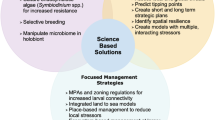Abstract
The tsunami that deeply impacted the North Indian Ocean shores on 26 December 2004, called for urgent rehabilitation of coastal infrastructures to restore the livelihood of local populations. A spatial and statistical analysis was performed to identify what geomorphological and biological configurations (mangroves forests, coral and other coastal vegetation) are susceptible to decrease or increase coastal vulnerability to tsunami. The results indicate that the width of flooded land strip was, in vast majority, influenced by the distance to fault lines as well as inclination and length of proximal slope. Areas covered by seagrass beds were less impacted, whereas areas behind coral reefs were more affected. The mangroves forests identified in the study were all located in sheltered areas, thus preventing to address the potential protecting role of mangroves forests.
Similar content being viewed by others
Abbreviations
- CRED:
-
Centre for Research on Epidemiology of Disasters
- DEM:
-
Digital Elevation Model
- FAO:
-
Food and Agriculture Organisation
- GIS:
-
Geographical Information System
- IFRC:
-
International Federation of the Red Cross
- UNEP:
-
United Nations Environment Programme
- UNEP/GRID:
-
United Nation Environment Programme, Global Resource Information Database
- WCMC:
-
World Conservation Monitoring Centre
- UTM:
-
Universal Transverse Mercator
- GPS:
-
Ground Positioning System
References
Articles and books
Dao H, Peduzzi P (2004) Global evaluation of human risk and vulnerability to natural hazards, In: Proc. EnviroInfo 2004 conference, vol 1, Editions du Tricorne, Geneva, Switzerland, pp 435–446
Davis JH Jr (1940) The ecology and geological role of mangroves. In: Florida Carnegie Inst. Wash., vol 32, Papers of the Tortugas Laboratory, pp 303–412
Field C (1996) Restoration of mangrove Ecosystems. International Tropical Timber Organization and International Society for Mangrove Ecosystems, Okinawa, Japan
Harada K, Latief H, Imamura F (2002) Effect on reducing tsunami by the green belt and coastal permeable structure, In: Proc. International Workshop on Tsunami Risk and Its reduction in the Asia-Pacific Region, Bandung, Indonesia, Session 4
Hiraishi T and Harada K (2003) Greenbelt tsunami prevention in South-Pacific Region. Report Port Airport Res Inst 42(2):1–23
IFRC (2002) Mangrove planting saves lives and money in Vietnam, World Disaster Report 2002, International Federation of Red Cross and Red Crescent Societies (IFRC)
Jimenez JA, Martinez R and Encarnocion L (1985) Massive tree mortality in Puerto Rican mangroves forests. Caribbian J Sci 21:75–78
Kairo JG, Dahdouh-Guebas F, Bosire J and Koedam N (2001) Restoration and management of mangrove systems – a lesson for and from the East African region. South African J Bot 67:383–389
Kowalik Z (2003) Basic relations between tsunamis calculation and their physics – II. Sci Tsunami Hazards 21(3):152–173
Lewis RR (1982) Mangrove forests. In: Lewis RR (ed) Creation and restoration of coastal plant communities. CRC Press, pp153–173
Mofjeld HO, Titov VV, Gonzalez FI and Newman JC (2000) Analytic theory of tsunami wave scattering in the open ocean with application to the North Pacific. NOAA Tech Memo OAR PMEL-116:1–38
Peduzzi P, Dao H and Herold C (2002) Global Risk And Vulnerability Index Trends per Year (GRAVITY), Phase II: Development, analysis and results, scientific report. UNEP, Geneva Switzerland
Thom BG (1967) Mangrove ecology and deltaic geomorphology, Tabasco, Mexico. J Ecol 55:301–334
UNEP (2005a) After the tsumani – rapid environmental assessment report. UNEP, Nairobi, pp 1–140
UNEP (2005b) Maldives post-tsumami environmental assessment. UNEP, Nairobi, Kenya, p 19
References on the Internet
CRED (2005), EM-Dat, disasters list, http://www.em-dat.net
Dao H (2004), Classificator, Dpt of Geography, Geneva University. http://geomap.unige.ch/sescat/stats/classify_func_example.html
DIPE (2002) Mangrove management in the Northern Territory, p. 5. Department of infrastructure planning and environment, Northern Territory Government, Darwin NT, Australia. http://www.lpe.nt.gov.au/dlpe/advis/land/mangrove/mangrovemgt/
DLR-ZKI (2005) ZKI satellite mapping supports international humanitarian relief teams in Southeast Asia, http://www.zki.caf.dlr.de/applications/2004/indian_ocean/indian_ocean_2004_en.html
DRS-DPRI (2005) The December 26, 2004 earthquake tsunami disaster of Indian Ocean, Kyoto University, http://www-drs.dpri.kyoto-u.ac.jp/sumatra/index-e.html
Fox R (2004) Water in motion, Department of Biology, Lander University, http://www.lander.edu/rsfox/415hydrodyn-1Lec.html
Friends of the Earth (2005) Coral reefs and mangroves may have helped saved lives http://www.foei.org/tsunami/malaysia.html
Khor M (2005), Save the Mangroves to fight tsunamis, Third World Network, http://www.twnside.org.sg/title2/gtrends39.htm
Nelson SA (2005) What is a Tsunami?, http://www.tulane.edu/~sanelson/geol204/tsunami.htm
NOAA (2004a) International tsunami information center, Tsunami Glossary, http://www.prh.noaa.gov/itic/library/pubs/glossary/tsu_glossary_html/tsunami_glossary11.html
NOAA (2004b) NOAA Backgrounder, NOAA and Tsunami, http://www.prh.noaa.gov/itic/tsunami_events/media/factsheets/backgrounder.pdf
Author information
Authors and Affiliations
Corresponding author
Rights and permissions
About this article
Cite this article
Chatenoux, B., Peduzzi, P. Impacts from the 2004 Indian Ocean Tsunami: analysing the potential protecting role of environmental features. Nat Hazards 40, 289–304 (2007). https://doi.org/10.1007/s11069-006-0015-9
Received:
Accepted:
Published:
Issue Date:
DOI: https://doi.org/10.1007/s11069-006-0015-9




